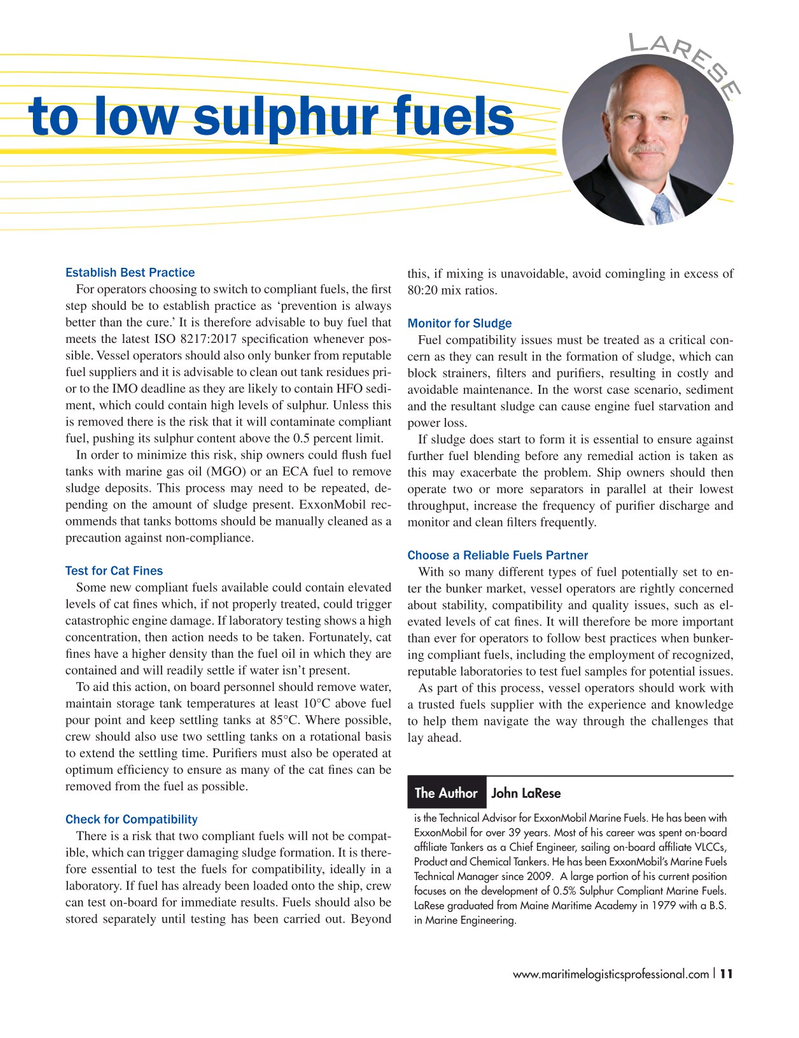
Page 11: of Maritime Logistics Professional Magazine (Jul/Aug 2018)
Port Infrastructure & Development
Read this page in Pdf, Flash or Html5 edition of Jul/Aug 2018 Maritime Logistics Professional Magazine
a
L r e s e to low sulphur fuels
Establish Best Practice this, if mixing is unavoidable, avoid comingling in excess of
For operators choosing to switch to compliant fuels, the ? rst 80:20 mix ratios.
step should be to establish practice as ‘prevention is always better than the cure.’ It is therefore advisable to buy fuel that Monitor for Sludge meets the latest ISO 8217:2017 speci? cation whenever pos- Fuel compatibility issues must be treated as a critical con- sible. Vessel operators should also only bunker from reputable cern as they can result in the formation of sludge, which can fuel suppliers and it is advisable to clean out tank residues pri- block strainers, ? lters and puri? ers, resulting in costly and or to the IMO deadline as they are likely to contain HFO sedi- avoidable maintenance. In the worst case scenario, sediment ment, which could contain high levels of sulphur. Unless this and the resultant sludge can cause engine fuel starvation and is removed there is the risk that it will contaminate compliant power loss.
fuel, pushing its sulphur content above the 0.5 percent limit. If sludge does start to form it is essential to ensure against
In order to minimize this risk, ship owners could ? ush fuel further fuel blending before any remedial action is taken as tanks with marine gas oil (MGO) or an ECA fuel to remove this may exacerbate the problem. Ship owners should then sludge deposits. This process may need to be repeated, de- operate two or more separators in parallel at their lowest pending on the amount of sludge present. ExxonMobil rec- throughput, increase the frequency of puri? er discharge and ommends that tanks bottoms should be manually cleaned as a monitor and clean ? lters frequently.
precaution against non-compliance.
Choose a Reliable Fuels Partner
Test for Cat Fines With so many different types of fuel potentially set to en-
Some new compliant fuels available could contain elevated ter the bunker market, vessel operators are rightly concerned levels of cat ? nes which, if not properly treated, could trigger about stability, compatibility and quality issues, such as el- catastrophic engine damage. If laboratory testing shows a high evated levels of cat ? nes. It will therefore be more important concentration, then action needs to be taken. Fortunately, cat than ever for operators to follow best practices when bunker- ? nes have a higher density than the fuel oil in which they are ing compliant fuels, including the employment of recognized, contained and will readily settle if water isn’t present. reputable laboratories to test fuel samples for potential issues.
To aid this action, on board personnel should remove water, As part of this process, vessel operators should work with maintain storage tank temperatures at least 10°C above fuel a trusted fuels supplier with the experience and knowledge pour point and keep settling tanks at 85°C. Where possible, to help them navigate the way through the challenges that crew should also use two settling tanks on a rotational basis lay ahead.
to extend the settling time. Puri? ers must also be operated at optimum ef? ciency to ensure as many of the cat ? nes can be removed from the fuel as possible.
The Author John LaRese is the Technical Advisor for ExxonMobil Marine Fuels. He has been with
Check for Compatibility
ExxonMobil for over 39 years. Most of his career was spent on-board
There is a risk that two compliant fuels will not be compat- af? liate Tankers as a Chief Engineer, sailing on-board af? liate VLCCs, ible, which can trigger damaging sludge formation. It is there-
Product and Chemical Tankers. He has been ExxonMobil’s Marine Fuels fore essential to test the fuels for compatibility, ideally in a
Technical Manager since 2009. A large portion of his current position laboratory. If fuel has already been loaded onto the ship, crew focuses on the development of 0.5% Sulphur Compliant Marine Fuels. can test on-board for immediate results. Fuels should also be
LaRese graduated from Maine Maritime Academy in 1979 with a B.S. stored separately until testing has been carried out. Beyond in Marine Engineering.
www.maritimelogisticsprofessional.com 11I 1-17 MLP JulyAug18.indd 11 1-17 MLP JulyAug18.indd 11 8/8/2018 9:03:04 AM8/8/2018 9:03:04 AM

 10
10

 12
12
